
| What is Flavor and Fortune? |
| How do I subscribe? |
| How do I get past issues? |
| How do I advertise? |
| How do I contact the editor? |
Read 6997131 times
Connect me to:
| Home |
| Articles |
| Book reviews |
| Letters to the Editor |
| Newmans News and Notes |
| Recipes |
| Restaurant reviews |
| Article Index (all years, slow) |
| List of Article Years |
| Article Index (2024) |
| Article Index (last 2 years) |
| Things others say |
| Related Links |
| Log In... |
| Authors |
| Categories & Topics |
Zhuang People in China
| by Jacqueline M. Newman |
Chinese Ethnic Minorities and Their Foods
Summer Volume: 2005 Issue: 12(3) page(s): 19 and 20
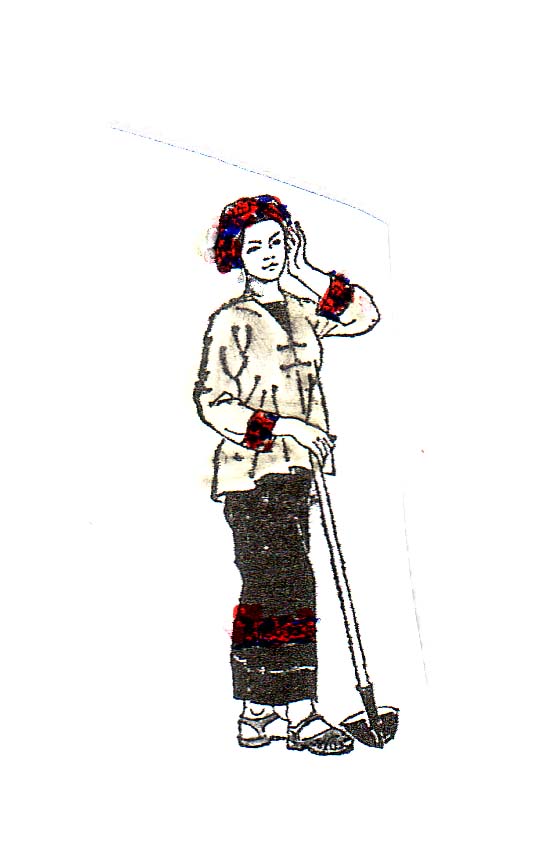 The Zhuang are China’s largest ethnic non-Han population. Tracing the roots of a people who number in the millions is no easy task. Much has been learned about this particular ethnic nationality who are believed descendants of the aborigines on the Lingnan area. A lot has been determined by studying a two thousand year old fresco in Hingming County, Guangxi, known as the 'Huashan Fresco.' It tells many tales as it is a hundred meters long and forty meters wide. This group of carvings includes more than thirteen hundred figures, most depicting the lives of Zhuang ancestors. It is believed to be the largest fresco among the more than fifty others that overhang the Zuojiang River. Together, they depict many things in the Zhuang lifestyle, and they visualize some of their history.
The Zhuang are China’s largest ethnic non-Han population. Tracing the roots of a people who number in the millions is no easy task. Much has been learned about this particular ethnic nationality who are believed descendants of the aborigines on the Lingnan area. A lot has been determined by studying a two thousand year old fresco in Hingming County, Guangxi, known as the 'Huashan Fresco.' It tells many tales as it is a hundred meters long and forty meters wide. This group of carvings includes more than thirteen hundred figures, most depicting the lives of Zhuang ancestors. It is believed to be the largest fresco among the more than fifty others that overhang the Zuojiang River. Together, they depict many things in the Zhuang lifestyle, and they visualize some of their history.
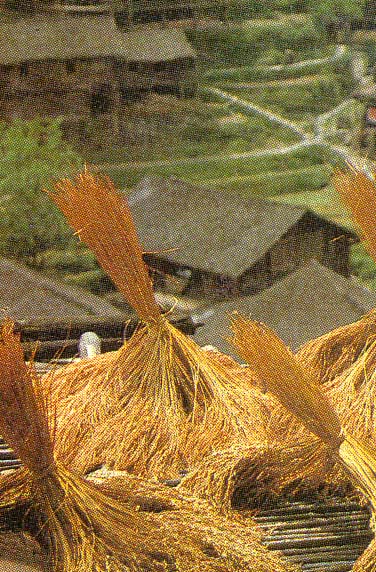 The last Chinese census indicates there are more than eighteen million Zhuang people living in China. Most of them live in the Zhuang Autonomous Region, which is in the Guangxi Province. The rest are scattered throughout the country, most in the Yunnan, Guangdong, Guizhou, and Hunan provinces.
The last Chinese census indicates there are more than eighteen million Zhuang people living in China. Most of them live in the Zhuang Autonomous Region, which is in the Guangxi Province. The rest are scattered throughout the country, most in the Yunnan, Guangdong, Guizhou, and Hunan provinces.
This huge ethnic population, about the same number as those living in Australia, have been known by many names. Over time, they have been known as Butu, Bunong, Buman, Buzhuang, and Buyayi people. Then, after the founding of new China, they were called Tong people. That name and the earlier ones are no longer used; as a matter of fact, many young folk have hardly heard them used or even know they once existed.
Names aside, the Zhuang are best known for their song fests. These generally are three days in length and are accompanied by dances. At them, they sing about love, tea-picking, their daily activities, and sometimes they sing about their food, and about chewing betel nuts, which they adore. And when they sing and dance, they dress in festive costumes which include long brocaded sashes, and brocade on their hats and trousers.
Zhuang songs are now known throughout China. This is because they were popularized by Third Sister Liu, particularly after a film was made about her in the 1950's. The Zhuang have always had singing festivals. In Chinese,they are called Gexujie; while in their language they have different names in different regions, including Huanlongdong, Xupeng, also Huanwogan. Held twice a year, these three-day events are on the third day of the third lunar month and again nearer the Chinese Mid-Autumn Festival; and there can be others.
At these events, when not singing or dancing, boys and girls court, and they like to play games related to food. A popular one incorporates hard-cooked red eggs. The object is to break one or both ends of another person’s egg. Being successful signifies a lucky relationship, so if a person likes someone in particular, they creatively let him or her break one or both ends of their egg.
Zhuang holidays are not Han-related. There is a New Year’s holiday which is called Drink Fresh Spring Water Day. On that day, girls get up early to rush to a spring and drink lots of its water. Why? Because they believe it clears the mind, makes them clever, and increases their ability to use their hands creatively and easily. Fellows, on that day and for some days thereafter, go off to catch frogs. Called a 'Frog-revering Time,' it can last up to one month. After finding and playing with the frogs, they bury them with song and dance.
Also at the New Year festival, families take to the woods surrounding their homes. They feed sweet-rice dumplings to the base of their trees, particularly to their fruit trees. The dumplings are placed at the base of the trees and freshly sifted dirt is put on top of them. Then, they sing to the trees, with wishes that they grow sweet fruit. When they return to their homes, they eat some of the same dumplings, and never eat any green vegetables on this day. To do so will bring lots of weeds and potential of crop failure.
Zhuang sing and dance on every holiday including on Ox Soul Festival Day, which is the eighth day of the fourth lunar month. For it and many others, they make five-color glutinous rice, not to eat, but to feed, along with fresh grass, to their cattle. They also remove the cattle’s yoke, bathe them, and put them out to pasture. Girls bring some spring water to them, and sing to the cattle. They also feed them black rice as they pray for a large harvest. Devil’s Festival Day is in summer. On this day, families prepare chicken, duck, and more five-colored glutinous rice. They offer it to their ancestors, and to other spirits.
Those who live near the border with Vietnam, have a new feasting festival. They celebrate repulsing of the French invaders in the 19th century. On this day and many others, they worship dragons, birds, trees, and their ancestors. They almost always make five-color rice and sing and dance to celebrate an occasion.
Most researchers believe the Zhuang are descendants of ancient Yue people in southern China, and that they are from a branch of the Baiyue. They use a Sino-Tibetan language, are a Zhuang-Dai branch, and many do not speak Chinese. Rather they have a language with its own undeveloped characters. In about 1955, with government assistance, they developed a written language based upon the Latin alphabet. At that time, they were encouraged to keep many of their ancient behaviors and their Polytheist beliefs.
Some archeologists, anthropologists, and historians report finding written records of Zhuang circa the start of the Song Dynasty (960 CE). Others date them before that, and as early as 221 BCE, to be specific. They think that during extensive unification, Qin Shi Huang conquered their ancestors. Still others say nonsense because they believe the Zhuang can be traced to Liujiang man who lived in paleolithic times some fifty thousand years ago west of Lingnan. Thus, tracing their past is as complex as tracing their current foods. One reason may be that over the millennia, Zhuang people have had the many names already mentioned and others including Butin, Buyue, Leng, Li, Liao, Tang, and To. Others include that where they lived encompassed large areas and different local foods.
Living in tropical and sub-tropical regions, no matter where they lived, the staple foods of the Zhuang were and are glutinous and non-glutinous rice. More recently, corn has been added to their food, that is for some hundreds of years. They grow both kinds of rice, sugar cane, yams, corn, potatoes, fennel, cinnamon, pseudo-ginseng, bananas, longans, lychees, pineapple, mango, and tea; and they consume all of them.
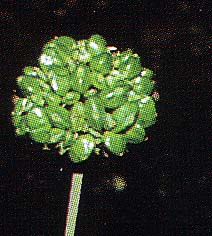
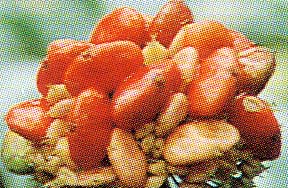

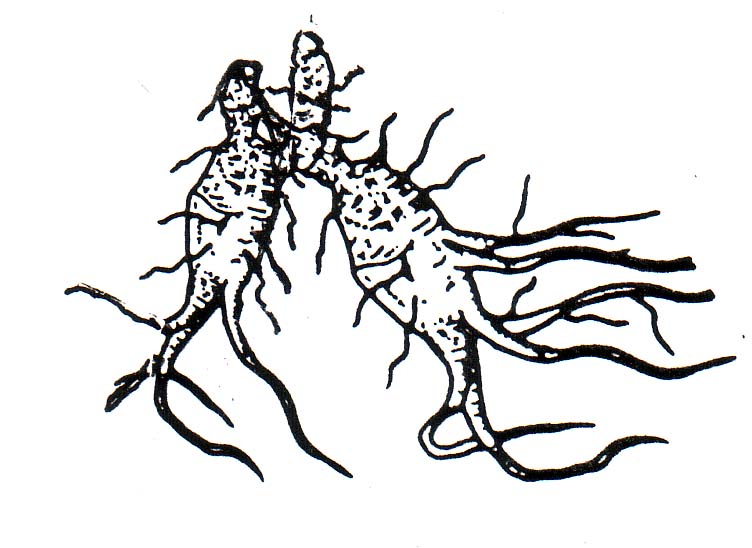 This ethnic population flavors many of their foods with Chinese cinnamon and fennel, and with the oils of both of them. They sometimes use pseudo-ginseng or they use tree oil in dishes, and they like to drink san qi hua cha which is tea made with the green unripe and orange ripe flowers as shown in these pictures, and/or the root of pseudo-ginseng, botanically known as notoginseng. Some Zhuang consume theirs with others without sugar in it. And, they use a reasonable amount of sugar in many of their dishes.
This ethnic population flavors many of their foods with Chinese cinnamon and fennel, and with the oils of both of them. They sometimes use pseudo-ginseng or they use tree oil in dishes, and they like to drink san qi hua cha which is tea made with the green unripe and orange ripe flowers as shown in these pictures, and/or the root of pseudo-ginseng, botanically known as notoginseng. Some Zhuang consume theirs with others without sugar in it. And, they use a reasonable amount of sugar in many of their dishes.
The Zhuang were and still are agriculturalists who raise and use lots of betel nuts, a grape-fruit-like item called a 'shaddock,' and all the items already mentioned. In addition to working the land, they raise and catch fish and also the gecko. Their homes are often of two-stories and they tie their rice in bundles and put these on their roofs to dry before husking. They sleep and eat on the second story and stable their animals below where they store their tools. The upstairs is usually one room, and they eat and bed down in this common room. As best we could learn, their favorite dishes include Black Rice Soup, Torch Pork, Zijiang Hare, Fried Pseudo-ginseng with Spotted frog, and Sweetened Eggplant. One of their favorite drinks is Pseudo-ginseng Tea. Because they live in many regions of China, these dishes are popular, but there are others, as well, andmany are regional. Try these, and should you locate recipes for others, do share them.
| Black Rice Soup |
|---|
1/3 pound black rice 3 Tablespoons sugar 1/8 teaspoon ground fennel 1/8 teaspoon ground Chinese cinnamon Preparation: 1. Rinse the black rice three to five times. 2. Put the rice, sugar, fennel, and cinnamon in a large heavy pot and add six cups cold water. Bring to the boil, reduce the heat, cover, and simmer for three hours. Then serve. |
| Sweetened Eggplant |
|---|
4 long thin eggplants, about twelve ounces 2 teaspoons rice vinegar 2 Tablespoons cornstarch 1/2 teaspoon white pepper 1/2 teaspoon cinnamon 1 Tablespoon sugar 1 teaspoon fermented glutinous rice 3 Tablespoons cornstarch 1 cup corn oil 1 teaspoon sesame oil 1 Tablespoon minced scallions, green part only Preparation: 1. Coarsely chop the eggplant, put it into a bowl, and soak in two cups of ice water mixed with the rice vinegar for ten minutes. Then drain well. 2. Mix eggplant with the two tablespoons of cornstarch, the white pepper, cinnamon, sugar, and the fermented rice. Steam over boiling water for ten minutes, then remove from the steamer, drain, and allow to cool. 3. Mix the three tablespoons of cornstarch with the eggplant mixture, and shape into two-inch flat patties. 4. Heat half of the oil, and fry half of the patties on one side until lightly brown, turn over and fry them on the other side until lightly brown. Remove and drain on paper towels while the other half of the oil is heated and the rest of the patties are fried on both sides. 5. Put the patties on a heated plate, sprinke with sesame oil and the scallions, and serve. |
| Pseudo-ginseng Tea |
|---|
1 teaspoon chopped dried pseudo-ginseng root 1 teaspoon pseudo-ginseng flower, fresh or dried (optional) Preparation: 1. Pour one cup boiling water over the ingredients and allow to steep for five to ten minutes. 2. Pour another cup of boiling water into the infusion, and serve. |

Copyright © 1994-2024 by ISACC, all rights reserved
Address
3 Jefferson Ferry Drive
S. Setauket NY 11720